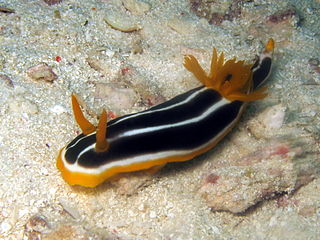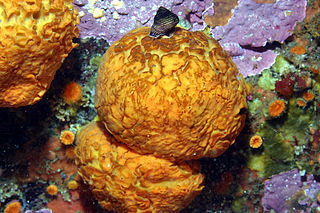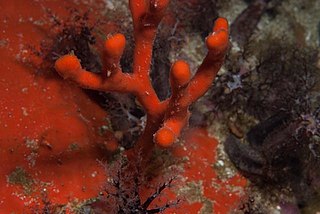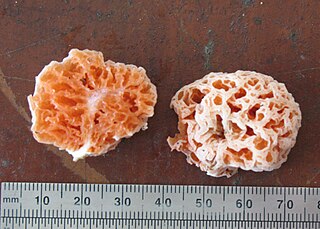
Hexactinellid sponges are sponges with a skeleton made of four- and/or six-pointed siliceous spicules, often referred to as glass sponges. They are usually classified along with other sponges in the phylum Porifera, but some researchers consider them sufficiently distinct to deserve their own phylum, Symplasma. Some experts believe glass sponges are the longest-lived animals on earth; these scientists tentatively estimate a maximum age of up to 15,000 years.

Clathrina coriacea is a species of calcareous sponge belonging to the class Calcarea and family Clathrinidae. Species in the genus Clathrina are composed of calcium carbonate tube-like skeletons containing spicules. The sponge can be located in shallow waters widely distributed along North Atlantic coasts, as well as on other coasts.

Chromodoris africana, or four-coloured nudibranch, is a species of colourful sea slug, a dorid nudibranch, a marine gastropod mollusc in the family Chromodorididae.

The orange wall sponge is a species of sea sponge belonging to the order Trachycladida. It is found in the south Atlantic and Indo-Pacific oceans. Around the South African coast, it is known from the Cape Peninsula to Cape Agulhas.

Tethya aurantium, also known as the golf ball sponge or orange puffball sponge, is a species of sea sponge belonging to the family Tethyidae. It is spherical in shape, with a warty surface, and grows to about 10 cm in diameter. Oscula are present on the upper surface. The surface has sharp protruding spicules which can cause skin irritation if touched.

The tree sponge is a species of demosponge. It is known from the west coast of South Africa to Cape Agulhas. It is endemic to this region.

Amphimedon compressa, the erect rope sponge, red tree sponge, red tubular sponge, or red sponge is a demosponge found in southern Florida, the Caribbean Sea, and the Bahamas. It can be deep red, orange, brown, or black.

Spongiforma is a genus of sponge-like fungi in the family Boletaceae. Newly described in 2009, the genus contains two species: S. thailandica and S. squarepantsii. The type species S. thailandica is known only from Khao Yai National Park in central Thailand, where it grows in soil in old-growth forests dominated by dipterocarp trees. The rubbery fruit bodies, which has a strong odour of coal-tar similar to Tricholoma sulphureum, consists of numerous internal cavities lined with spore-producing tissue. S. squarepantsii, described as new to science in 2011, is found in Malaysia. It produces sponge-like, rubbery orange fruit bodies with a fruity or musky odour. These fruit bodies will—like a sponge—resume their original shape if water is squeezed out. The origin of the specific name derives from its perceived resemblance to the cartoon character SpongeBob SquarePants. Apart from differences in distribution, S. squarepantsii differs from S. thailandica in its colour, odour, and spore structure.

Spongiforma squarepantsii is a species of fungus in the family Boletaceae, genus Spongiforma. Found in Malaysia, it was described as new to science in 2011. It produces sponge-like, rubbery orange fruit bodies that have a fruity or musky odour. The fruit bodies reach dimensions of 10 cm (3.9 in) wide by 7 cm (2.8 in) tall. Like a sponge, they will resume their original shape if water is squeezed out. The spores, produced on the surfaces of the hollows of the sponge, are almond-shaped with rough surfaces, and measure 10‑12.5 μm by 6‑7 μm. The name of the fungus derives from the Nickelodeon cartoon character SpongeBob SquarePants from the show of the same name. S. squarepantsii is one of two species in Spongiforma; it differs from S. thailandica in its color, odour, and spore structure.

Sagartia elegans, the elegant anemone, is a species of sea anemone in the family Sagartiidae. It is found in coastal areas of northwest Europe at depths down to 50 metres.
Cliona delitrix is a species of burrowing demosponge belonging to the family Clionaidae. It is found in shallow water in the Caribbean Sea and the Gulf of Mexico.

Mycale laevis, the orange icing sponge or orange undercoat sponge, is a species of marine demosponge in the family Mycalidae. Mycale is a large genus and this species is placed in the subgenus Mycale making its full name, Mycale (Mycale) laevis. This sponge is found in the Caribbean Sea and the Gulf of Mexico and usually grows in association with a small group of coral genera.

Clavulinopsis sulcata is a clavarioid fungus in the family Clavariaceae and is the type species of the genus Clavulinopsis. It forms very long, slender, cylindrical pinkish or orange fruiting bodies that grow on the ground among plant litter. A vernacular name that has been used for the species is flame fungus.
Fibulia ramosa, or the columnar sponge, is a species of deep-sea demosponge from the southern hemisphere.
Antho prima, or Antho (Acarnia) prima also known as the orange fan sponge is a species of sponge belonging to the genus Antho found on the south coast of South Africa and the coast of New Zealand.
Clathria lissoclada, the triangular blade sponge, is a species of demosponge from the southern hemisphere.
Ectyonopsis pluridentata, the fused branch sponge, is a species of demosponge from South Africa.
Polymastia bouryesnaultae, the knobbly sponge, is a small and cryptic species of demosponge from South Africa and Namibia.
Penares sphaera, the crater sponge, is a deep sea demosponge from southern Africa.

Thuridilla vataae is a species of sacoglossan sea slug, a shell-less marine opisthobranch gastropod mollusc in the family Plakobranchidae. It is native to the tropical Indo-Pacific. It was first described by the French zoologist Jean Risbec in 1928; its specific name refers to the Bay of Anse Vata, just south of Nouméa, New Caledonia, where the type specimen was collected.











